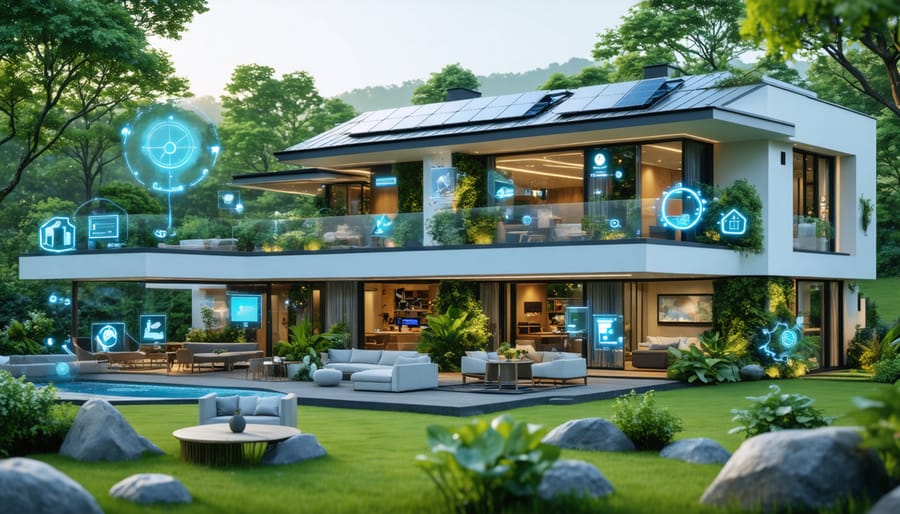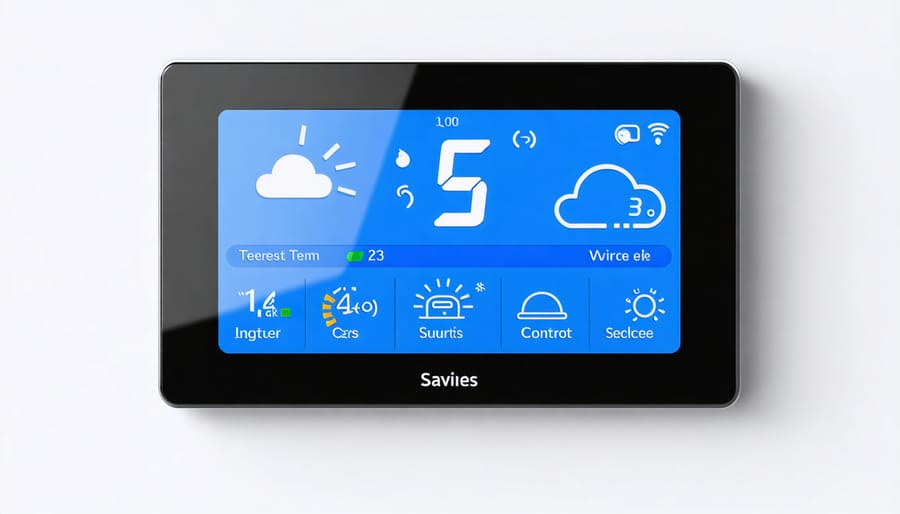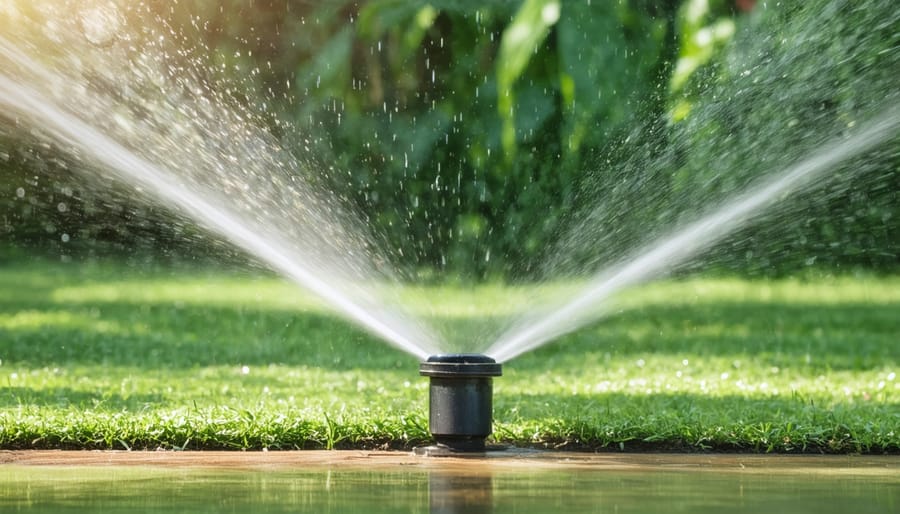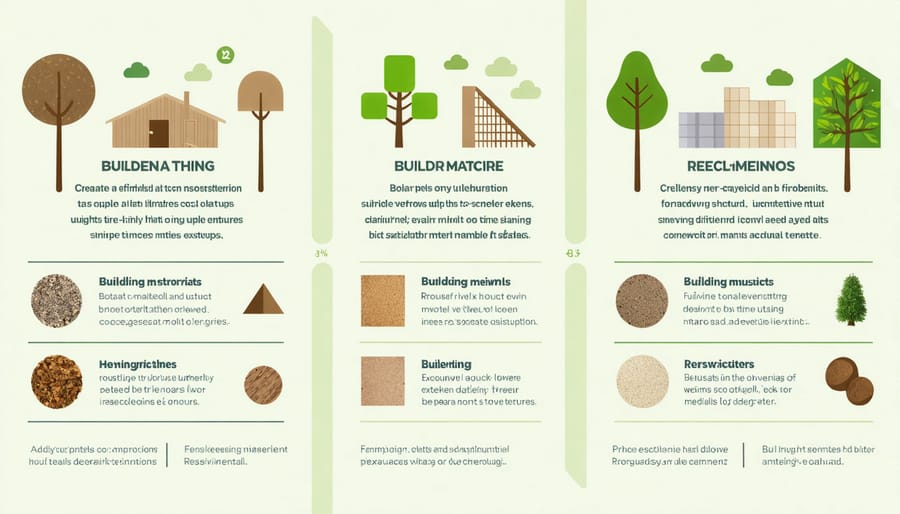
Smart Home Solutions That Actually Help Save the Planet (And Your Money)
Transform your home into an eco-friendly sanctuary with smart technology that slashes energy bills and reduces your carbon footprint. Install programmable LED lighting systems that automatically adjust based on natural daylight, cutting electricity usage by up to 75% compared to traditional bulbs. Replace outdated appliances with ENERGY STAR certified models, which consume 40-60% less energy and often qualify for local tax incentives. Create a zero-waste kitchen using smart composting systems and energy-monitoring devices that track real-time consumption patterns.
Modern eco-friendly solutions have evolved far beyond basic recycling bins and LED bulbs. Today’s intelligent home systems integrate seamlessly with smartphone apps, allowing precise control over heating, cooling, and water usage from anywhere. Smart thermostats learn your schedule and optimize temperature settings, while advanced water sensors detect leaks instantly and automatically shut off supply to prevent waste.
The best part? These eco-friendly upgrades not only protect our planet but also deliver significant financial returns. Homeowners who implement comprehensive green solutions typically see a 30% reduction in utility bills within the first year, while increasing their property’s market value by 3-5%.
Energy-Efficient Smart Technology That Makes a Real Difference
Smart Thermostats and HVAC Controls
Smart thermostats and modern HVAC controls represent a significant leap forward in helping homeowners reduce energy consumption while maintaining optimal comfort. These intelligent systems learn your temperature preferences and daily routines, automatically adjusting settings to avoid wasting energy when rooms are unoccupied.
Popular models like the Nest Learning Thermostat and Ecobee SmartThermostat offer features such as smartphone control, occupancy sensing, and weather-based adjustments. They can cut heating and cooling costs by up to 15-20% annually, making them a smart investment for eco-conscious homeowners.
Installation is typically straightforward, with most models compatible with existing HVAC systems. Many smart thermostats provide detailed energy reports and suggestions for improving efficiency. Some even integrate with other smart home devices, creating a comprehensive energy management system.
Key features to look for include:
– Multi-zone temperature control
– Humidity monitoring
– Voice assistant compatibility
– Energy usage reporting
– Remote access via mobile apps
– Maintenance alerts
Beyond the environmental benefits, these systems can qualify homeowners for energy rebates and tax incentives. Many utility companies offer special programs for smart thermostat users, providing additional savings through demand response programs.
For optimal results, pair your smart thermostat with proper insulation and regular HVAC maintenance. This combination ensures maximum efficiency and the smallest possible carbon footprint.

Automated Lighting Systems
Automated lighting systems represent one of the most effective ways to reduce your home’s energy consumption while adding convenience to your daily routine. These smart solutions combine motion sensors, timers, and mobile connectivity to ensure lights are only on when needed, potentially cutting your lighting energy usage by up to 75%.
Modern automated lighting systems offer features like occupancy detection, which automatically turns lights off in empty rooms, and daylight harvesting, which adjusts artificial light levels based on available natural light. Many systems can be controlled through smartphone apps, allowing you to monitor and adjust your lighting from anywhere.
Installing smart bulbs is an excellent entry point into automated lighting. These LED bulbs connect to your home’s WiFi network and can be programmed to follow your daily schedule. For example, you can set them to gradually brighten in the morning for a natural wake-up experience or automatically dim in the evening to support your body’s natural sleep cycle.
For maximum efficiency, consider combining automated lights with motion sensors in areas like hallways, bathrooms, and outdoor spaces. This setup ensures lights only activate when someone is present and automatically turn off after a set period of inactivity. Many systems also offer features like vacation mode, which can simulate occupancy while you’re away, providing both security and energy savings.
Remember to choose Energy Star certified products when upgrading your lighting system, as these meet strict energy efficiency guidelines while maintaining high performance standards.
Water Conservation Made Simple
Smart Irrigation Systems
Smart irrigation systems represent a game-changing solution for environmentally conscious homeowners looking to maintain beautiful landscapes while conserving water. These advanced systems combine weather monitoring, soil moisture sensors, and smartphone connectivity to deliver precise amounts of water exactly when your plants need it.
Unlike traditional sprinklers that operate on timers regardless of conditions, smart irrigation controllers adjust watering schedules based on real-time weather data and soil conditions. They can detect rainfall, measure soil moisture levels, and even factor in plant types to create customized watering zones. This intelligent approach not only promotes healthier plant growth but can reduce water consumption by up to 50%.
Installation is surprisingly straightforward for DIY enthusiasts. Most systems include user-friendly apps that guide you through setup and allow remote control of your irrigation schedule. When paired with other sustainable materials and eco-friendly landscaping choices, these systems create a truly environmentally responsible outdoor space.
Key features to look for include:
– Weather monitoring capabilities
– Zone-specific programming
– Mobile app integration
– Flow sensors to detect leaks
– EPA WaterSense certification
For optimal results, consider combining your smart irrigation system with rain barrels or greywater recycling systems to further reduce your environmental impact while keeping your garden lush and vibrant.

Water-Monitoring Devices
Modern water-monitoring devices are revolutionizing how we manage our home’s water consumption, making it easier than ever to maintain an eco-friendly household. These smart devices work alongside other sustainable solutions, like energy-efficient insulation options, to create a comprehensive green living space.
Smart water meters attach directly to your main water line and provide real-time usage data through user-friendly smartphone apps. These devices can detect leaks, unusual usage patterns, and even predict potential issues before they become costly problems. Popular models like the Flume Water Monitor and Phyn Plus Smart Water Assistant can alert you instantly when they detect a drip or burst pipe.
For more targeted monitoring, faucet-mounted devices offer precise tracking of individual tap usage. These affordable attachments display water temperature and consumption data while encouraging mindful usage through LED indicators that change color based on water flow rates.
Smart irrigation controllers are another game-changer for outdoor water management. These WiFi-enabled systems use local weather data and soil moisture readings to optimize watering schedules, potentially reducing outdoor water usage by up to 50%. They’re particularly effective when paired with rain sensors that automatically pause watering during precipitation.
For tech-savvy homeowners, whole-house water monitoring systems integrate seamlessly with existing smart home platforms, offering voice-controlled features and automated shut-off capabilities during emergencies.
Sustainable Materials and Design Choices

Recycled and Sustainable Building Materials
Choosing sustainable building materials isn’t just good for the environment – it’s a smart investment in your property’s future. Recycled and eco-friendly materials have come a long way, offering durability and style while reducing environmental impact.
Reclaimed wood stands out as a versatile option, perfect for flooring, accent walls, and custom furniture. Salvaged from old buildings or fallen trees, each piece tells a unique story while preventing deforestation. For structural elements, engineered bamboo provides exceptional strength and grows significantly faster than traditional timber.
Recycled steel and aluminum are revolutionizing modern construction, offering superior strength with a fraction of the environmental impact of new metal production. These materials are particularly effective for framework and roofing, with recycled steel using up to 95% less energy to produce than virgin steel.
Cork flooring has gained popularity for its natural beauty and sustainability. Harvested from living cork oak trees without harming them, it provides excellent insulation and sound dampening properties. Similarly, recycled glass tiles add stunning visual elements while keeping glass out of landfills.
For insulation, recycled denim and cellulose (made from recycled paper) offer excellent thermal properties without the harmful chemicals found in traditional options. These materials are safe to handle and can significantly reduce energy costs.
Concrete alternatives like hempcrete and recycled aggregate concrete demonstrate how innovation meets sustainability. These materials sequester carbon dioxide and reduce the environmental impact of traditional concrete production while maintaining structural integrity.
When selecting materials, look for certifications like FSC (Forest Stewardship Council) for wood products and cradle-to-cradle certification for manufactured items to ensure genuine environmental benefits.
Energy-Efficient Windows and Insulation
When it comes to maintaining a comfortable home temperature while reducing energy costs, windows and insulation are your best allies. Modern energy-efficient windows feature double or triple-pane glass filled with insulating gas, dramatically reducing heat transfer compared to traditional single-pane windows. Look for windows with a low-E coating, which reflects heat while allowing natural light to pass through, keeping your home cooler in summer and warmer in winter.
Proper insulation is equally crucial for temperature regulation. Start with your attic, where up to 25% of your home’s heat can escape. A layer of quality fiberglass or cellulose insulation with an R-value of 30 or higher can significantly impact your energy bills. Don’t forget about walls – blown-in insulation can be added to existing walls without major renovation, while spray foam insulation creates an excellent air barrier in new construction.
Smart window treatments complement these solutions perfectly. Cellular shades create air pockets that provide additional insulation, while thermal curtains add an extra barrier against heat loss. For a tech-savvy approach, consider smart blinds that automatically adjust based on the time of day and temperature.
Draft-proofing is another essential step. Use weatherstripping around windows and doors, and seal any gaps with caulk. Pay special attention to areas where pipes or cables enter your home, as these are common spots for air leaks.
These improvements not only reduce your carbon footprint but can lead to significant savings – typically 15-30% on energy bills. While the initial investment might seem substantial, the long-term benefits to both your wallet and the environment make it worthwhile.
DIY Installation and Setup Tips
Getting started with eco-friendly home upgrades doesn’t have to be complicated. Follow these straightforward steps to transform your space into an environmentally conscious haven:
1. Smart Thermostat Installation
– Turn off power at the circuit breaker
– Remove old thermostat cover and take a photo of the wiring
– Label each wire according to its terminal
– Disconnect wires and remove old mounting plate
– Install new mounting plate and connect wires
– Attach display unit and restore power
– Follow manufacturer’s app setup instructions
2. LED Lighting Implementation
– Create a lighting inventory of your home
– Replace bulbs one room at a time
– Match lumens (brightness) rather than watts
– Consider color temperature (2700K for warm, 5000K for daylight)
– Install smart LED bulbs in high-traffic areas
– Set up automation schedules through your smartphone
3. Water Conservation Fixtures
– Shut off water supply before starting
– Remove old faucet aerators and showerheads
– Clean threading thoroughly
– Apply plumber’s tape to threads
– Install new low-flow fixtures
– Test for leaks and adjust flow as needed
4. Smart Power Strip Setup
– Identify major energy-consuming devices
– Group related electronics together
– Connect primary device to control outlet
– Connect secondary devices to switched outlets
– Configure auto-shutoff settings
– Test the system by turning off primary device
5. Motion Sensor Installation
– Choose optimal placement points
– Mark mounting locations
– Install mounting brackets
– Connect wiring (if hardwired) or insert batteries
– Adjust sensitivity and timing settings
– Test coverage area and make adjustments
Remember to:
– Read all manufacturer instructions before starting
– Document your existing setup with photos
– Keep all packaging until successful installation
– Test each component thoroughly
– Update related apps and software
– Schedule regular maintenance checks
These installations typically take between 30 minutes to 2 hours each, depending on your experience level and the complexity of the system.
Embracing eco-friendly solutions in our homes isn’t just about protecting the environment – it’s about creating a better, more sustainable future while enjoying immediate benefits today. By implementing these green technologies and practices, we can significantly reduce our carbon footprint while saving substantial amounts on utility bills.
From smart thermostats that optimize our energy usage to water-saving fixtures that preserve our precious resources, each small change contributes to a larger positive impact. Solar panels and energy-efficient appliances might require initial investment, but the long-term savings and environmental benefits make them worthwhile additions to any property.
Remember, going green doesn’t mean sacrificing comfort or convenience. Modern eco-friendly solutions are designed to enhance our living spaces while working harmoniously with our daily routines. Whether you’re starting with simple LED bulb replacements or planning a complete solar system installation, every step counts toward a more sustainable home.
Take action today by choosing one or two solutions that best fit your lifestyle and budget. Start small, monitor the results, and gradually expand your eco-friendly home improvements. The sooner we embrace these changes, the better our homes will perform, and the greater our contribution to environmental preservation will be. Your journey toward a greener home isn’t just an investment in your property – it’s an investment in our planet’s future.
